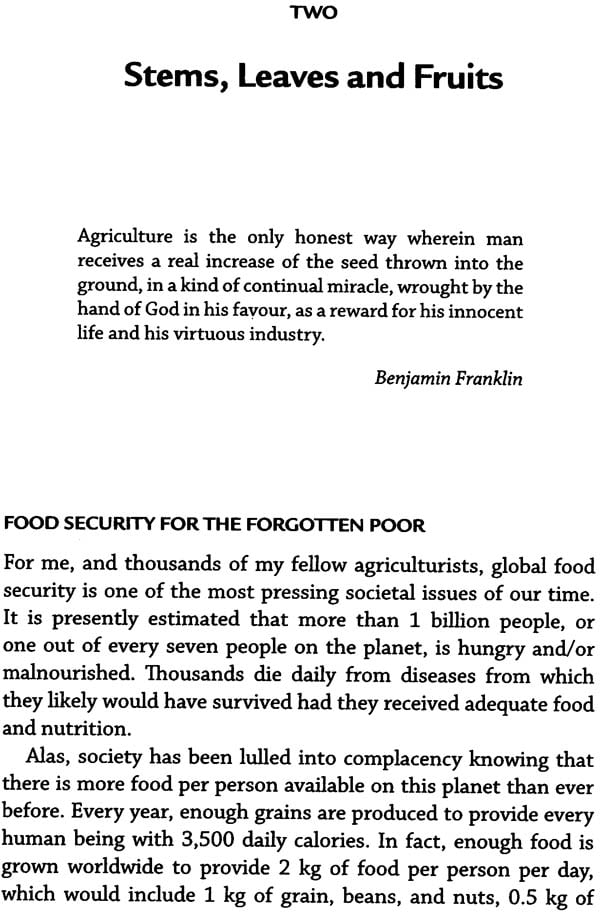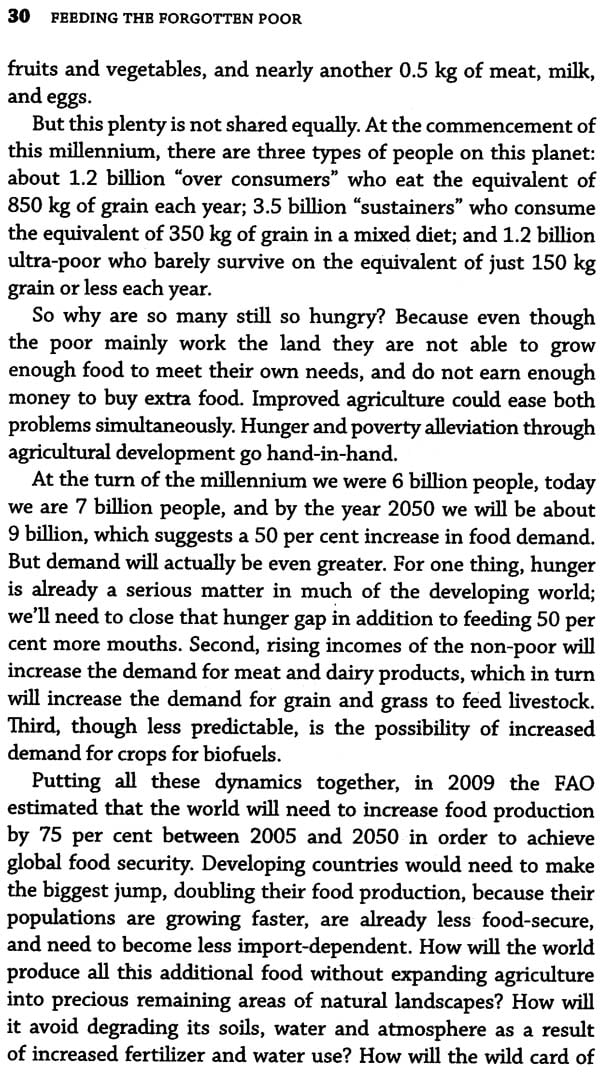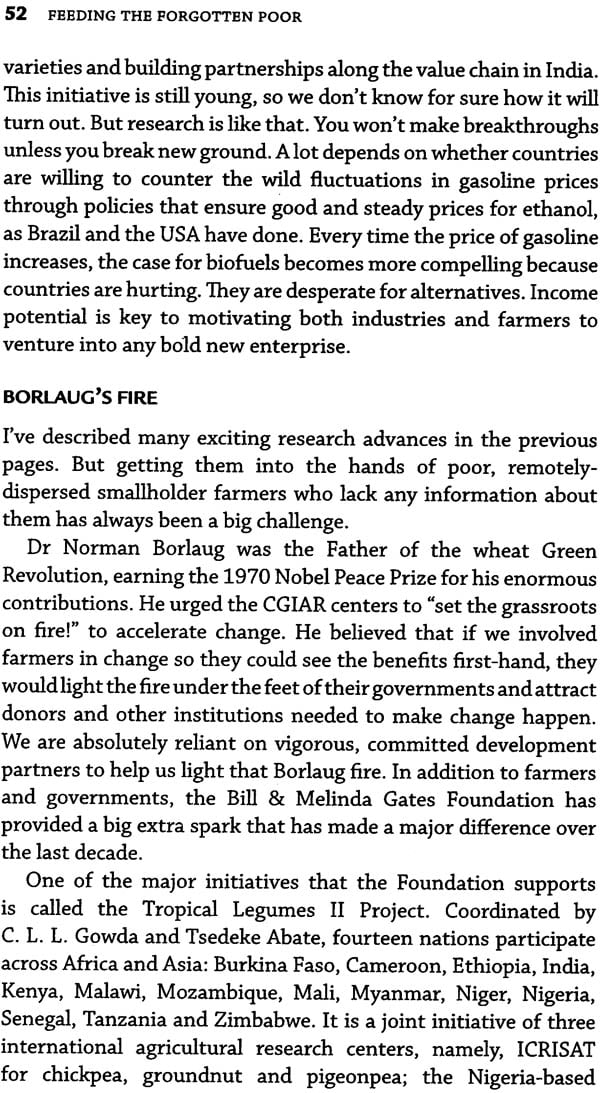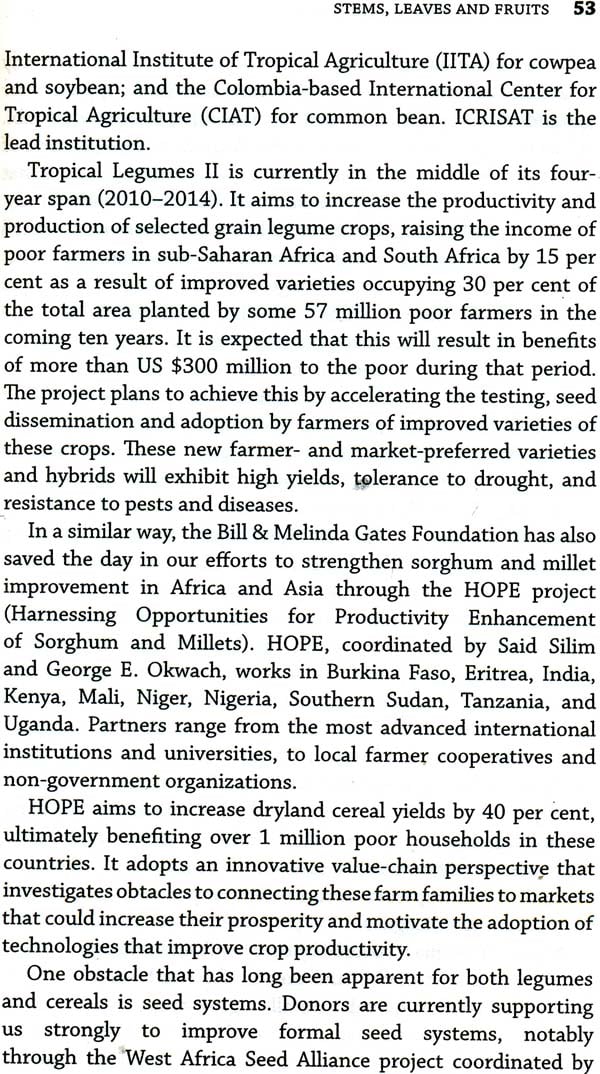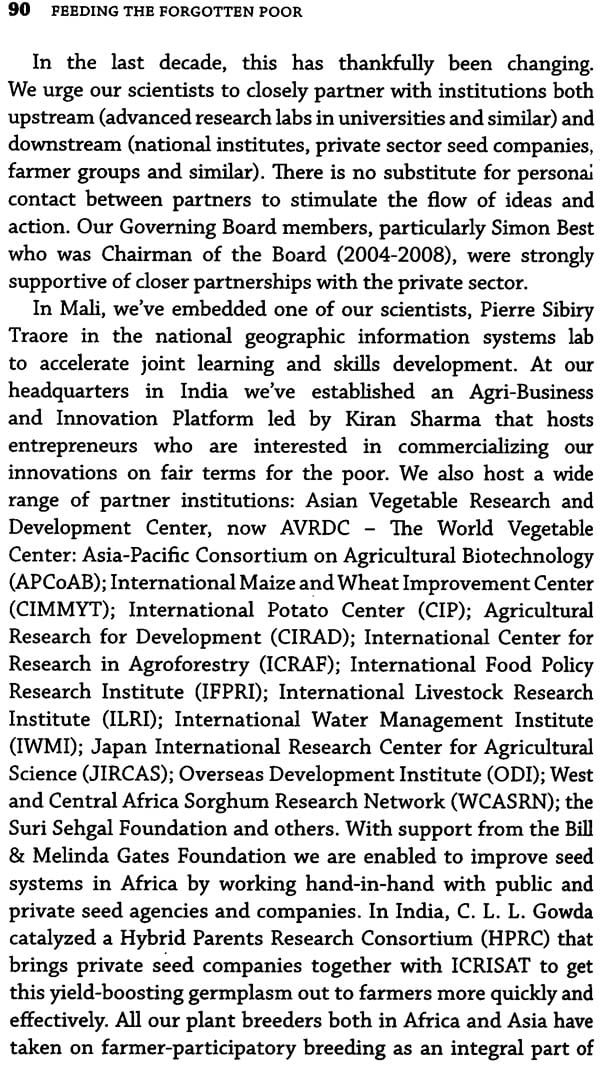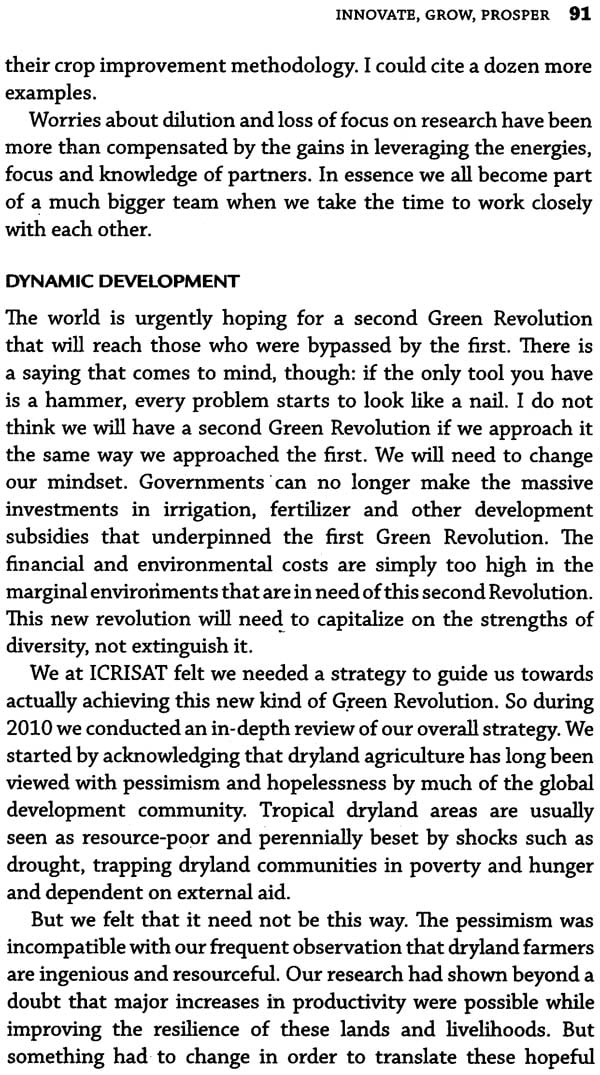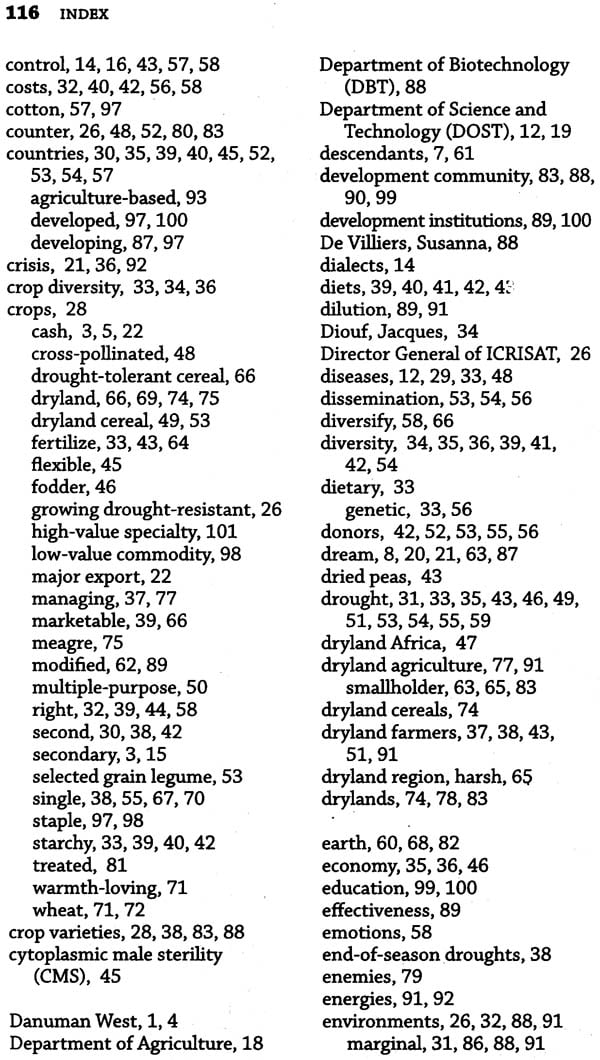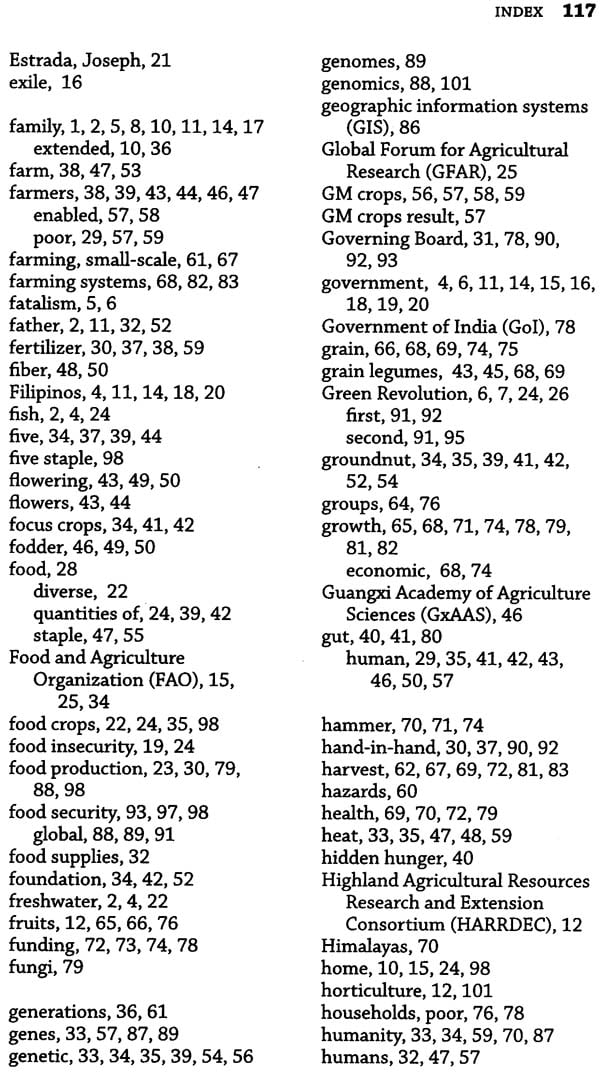
Feeding The Forgotten Poor: Perspectives of an Agriculturist (With CD Inside)
Book Specification
| Item Code: | NAI397 |
| Author: | William Dollente Dar with Arun Tiwari |
| Publisher: | Orient Blackswan Pvt. Ltd. |
| Language: | English |
| Edition: | 2013 |
| ISBN: | 9788125045588 |
| Pages: | 144 (20 B/W Illustrations) |
| Cover: | Paperback |
| Other Details | 8.5 inch X 5.5 inch |
| Weight | 190 gm |
Book Description
About the Book
Boosting food security and ensuring the small cultivator’s proper access to and a fair deal in the market have been the key areas of William Dar’s work as scientist, policymaker and administrator.
Feeding the Forgotten poor is an autobiography in which personal reminiscences serve as a vehicle for voicing concern for the disprivileged. It takes up large issues and draws attention to “orphan crops” and “hidden hunger”. Nothing that more than one billion of the world’s seven billion people go hungry or are malnourished, the book critically examine the political, economic and environmental issues to which contemporary agriculture is closely tied-tariffs and farm subsidies, water pollution, biofuels, the prospects and problems of genetically modified organisms, the growing backlash against mechanised agriculture and increasing support for sustainable practices.
About the Author
William D. Dar is the first Asian and Filipino Director General of the International Crops Research Institute for the Semi-Arid Tropics (ICRISAT). He has also been a member of the UN Millennium Task Force on Hunger. Prior to joining ICRISAT, Dar served as Secretary of Agriculture in the Philippines.
Arun Tiwari is CEO of the Indo-US Healthcare Pvt. Ltd., and teaches in the School of Management Studies at the University of Hyderabad.
Foreword
I was going through the book Feeding the Forgotten Poor by Dr William Dar. This book indeed reveals perspectives on how to grow and provide food to the people wherever they live on Earth, backed by the author’s own experience in many countries. I am particularly impressed with the chapter “Innovate, Grow and Prosper” where he deals with strategic science and dynamic development. I share his optimism and belief in the future.
In the chapter “Skin of the Earth” Dr William Dar brings out well the problems faced by contemporary agriculture. In the beautifully written section Enemies of our Enemies, he tells us crops must compete with ten thousand species of plant-eating insects and three hundred species of nematodes. He also provides solutions. This book is timely and will be very useful to farmers, scientists and policy makers.
At this juncture, I would like to share three memorable experiences based on my association with people involved in development works in Bihar, Tamil Nadu and Gujarat. The use of scientific method of farming involving soil characterization, matching the right seed to soil, seeding in time, fertilizer and pesticide selection, and water management has more than doubled pre- and post-harvesting productivity. This method began in 2000 in Bihar at the RP Channel 5 and Majholi distributory and was quite successful. The productivity of paddy increased from 2 tons per hectare to 5.8 tons per hectare, while wheat productivity increased from 0.9 ton per hectare to 2.6 tons per hectare. Currently, paddy and wheat crops are spread over an area larger than twenty-five hundred hectares involving three thousand farmers.
In Tamil Nadu, the Precision Farming Project started in Dharmapuri district in 2004-05. It was implemented initially in 250-acres in 2004-05, 500 acres in 2005-06, and 250 acres in 2006-07. In this project, the information gathered is used more precisely to evaluate optimum sowing density and to estimate fertilizer and other input needs, as well as to more accurately predict crop yields. It helps avoid cropping practices unsuitable to local soil/climate conditions, e.g., it reduces labour, water and inputs such as fertilizers, pesticides etc., and assures quality produce.
The Gujarat agriculture sector’s 9 per cent growth, which has been maintained and sustained over the last seven years, is a great success story. This has been achieved by the mission mode action of the Gujarat government. Determined not to give free power to farmers, the Gujarat government instead ensured a three-phase electrical supply by payment on 24/7 basis. This was done by reorganizing the power distribution channels by installing state-of-the-art gadgets and by segregating the power distribution between domestic consumption and agricultural consumption. Micro-irrigation facilities were established on a wider scale across the state which brought twenty thousand hectares under the micro-irrigation scheme. Due to the construction of check dams, even those areas that face perennial water scarcity have seen an increase in the water table by 3 to 12 m. Within just three years over seventy-five thousand of these structures were created.
During a recent interaction with farmers at Paliganj, Bihar, one farmer told me, “Sir we don’t want any subsidy. All we want is certified good quality seeds, good quality fertilizer and above all, fair price for our efforts,” I feel these three examples and the simple assertions of a farmer capture well the theme of this book and indeed validate the perspective of Dr William Dar. I have no doubt that India and developing countries across continents will succeed in growing and providing food to every person on their lands. As a tribute, let me say that Dr William Dar speaks from experience. He was born in a poor smallholder farming family in the Philippines. He knows and understands both the difficulties and the honour of that livelihood. He knows what the poor want and hope for. He is both a son of the soil and a visionary on major global issues.
We live in crucial times. Our very existence on this planet is threatened like never before. It is as if we are trapped in the cabin of a runaway train. We seem unable to slow the negative momentum of environmental destruction. It is not yet clear to us how we will switch that train to the track of sustainable development. We are continuously taking from this Earth. We must now start giving to this planet instead. I pray that Dr William Dar succeeds in his mission. May his tribe increase!
Contents
| Foreword | vii | |
| Figures | x | |
| Map of the Philippines | xx | |
| Abbreviations | xxi | |
| 1. | Soil and Roots | 1 |
| The dawn | 1 | |
| I stand by | 4 | |
| Meanwhile, a revolution | 6 | |
| City of the pines | 8 | |
| The right choice | 10 | |
| My country, my people | 11 | |
| Breaking through | 17 | |
| Finding my dream | 20 | |
| A larger stage | 23 | |
| Science with a human face | 25 | |
| 2. | Stems, Leaves and Fruits | 29 |
| Food security for the forgotten poor | 29 | |
| Diversity is strength | 32 | |
| Homogenize, or adapt? | 36 | |
| Hidden hunger | 39 | |
| Plastic peas | 43 | |
| At the desert’s edge | 47 | |
| Food, fodder, feed, fiber, fuel | 49 | |
| Borlaug’s fire | 52 | |
| Rope, or snake? | 56 | |
| 3. | Skin of the Earth | 60 |
| Planet under pressure | 60 | |
| Regaining our footing | 62 | |
| Mixing it up | 64 | |
| Hammer on anvil | 70 | |
| Quenching our thirst | 74 | |
| Enemies of our enemies | 79 | |
| A climate of uncertainty | 81 | |
| 4. | Innovate, Grow, Prosper | 85 |
| Strategic science | 85 | |
| Dynamic development | 91 | |
| Epilogue: a future to believe in | 98 | |
| Glossary | 103 | |
| Index | 115 |
